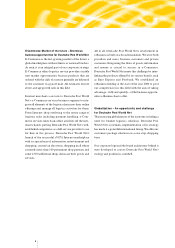DHL 1999 Annual Report Download - page 21
Download and view the complete annual report
Please find page 21 of the 1999 DHL annual report below. You can navigate through the pages in the report by either clicking on the pages listed below, or by using the keyword search tool below to find specific information within the annual report.
20
We believe that the combination of several different
sales channels such as call centers, the Internet and
traditional advisory services opens up good sales
opportunities for banks.
Looking at traditional stationary banking offered
through retail outlet networks, the interaction be-
tween the customer and his advisor takes center stage.
A fundamental feature of retail outlet networks that
are geared to meet the demands of the future is the
presence of a special area for one-on-one consulta-
tions and the provision of top organizational and
technical support for the bank’s advisors.
Internet trade in goods and services is giving rise to
an entirely new kind of service, namely, the certi-
fication of digital signatures, a security standard for
e-Commerce.We believe that banks with a nationwide
network of retail outlets are also best qualified for
acting as certification offices – and can create greater
customer loyalty in the process.
Today’s customer particularly expects his or her bank
to offer a broad range of products which include not
only traditional savings vehicles but also new and
attractive investment instruments such as stocks and
funds. The demand for additional financial services
(building loans, new types of payment transactions)
is also growing,whereby a strong nationwide presence
makes it possible to maintain direct customer contact
and offers opportunities for cross selling, as seen in
the case of banks and insurance companies.
The strategy aims at achieving a portfolio of invest-
ment, credit and annuity products. The many syner-
gies to be found between products by banks and
insurance companies provide a favorable platform for
such activities:
• The products and services currently available in the
marketplace are moving increasingly into line with
one another.
• They share the same customers.
• There are similarities in their production.
• Their sales channels function similarly.
We believe that in the long term only those players will
succeed who, on the one hand, efficiently bundle their
sales channels and staff them with competent personnel
and,on the other hand,offer a broad standardized prod-
uct range that meets every customer’s demands, at rea-
sonable prices.
3. Regulatory conditions
Only in the letter market does Deutsche Post World Net
have to deal with any particular regulatory requirements.
3.1. Postal Act
The EU Directive on competition in the European
postal market reserves the conveyance of all items up to
a maximum weight of 350 grams for existing national
post offices. Germany reorganized its entire postal sec-
tor following the Postal Reform I which became effec-
tive in 1990.With the passage of its Postal Act,Germany
has become one of Europe’s leaders in implementing the
EU Postal Service Directive and in liberalizing its postal
markets. Germany’s Postal Act divides postal services
into three categories: the exclusive license area, the area
that is subject to license, and the area which is open to
competition and does not require a license. The special
burdens that Deutsche Post World Net bears are partially
covered by the revenues it generates in the exclusive
license area.
























